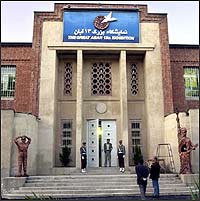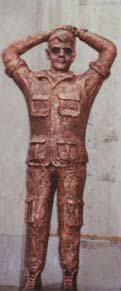Meanwhile, Attitudes Shifting Iran
 |
| Former American Embassy, Tehran (AP)
|
At the time of the Islamic Revolution, 22 years ago, the U.S.
was the Great Satan. Now, a comparatively temperate view of
the U.S. is becoming common. So much so that hardliners felt
they needed to educate young Iranians about the true nature
of what they call "global arrogance." A recently-opened
an exhibition in Tehran celebrates the Revolution's most glorious
moment, the seizure of the American embassy.
Called Smashing the Glassy Palace, it turns the embassy into
a kind of museum of American horrors.
In the first part of the exhibit, there is a sequence of rooms
dedicated to each of the countries where America has committed
what the organizers consider evil: Korea, Japan, Palestine.
The displays are like 1960's agit prop run amok.
The corridor's are filled with high school students bussed
in for the afternoon. They giggle and chatter and seem grateful
for the opportunity for getting out of class.
After visiting the various rooms of American wrongdoing, we
went to the perfectly preserved security and intelligence wing
of the Embassy. Behind the thick steel doors we saw the glass
room, which gives the exhibition its name. In this perfectly
secure, unbugged environment, America's ambassador and his intelligence
team discussed the crumbling regime of the Shah.
 |
| Statue of American soldier outside Embassy
Exhibition(AP) |
Curiously, there is no room dedicated to what is arguably America's
one true crime in Iran: the 1953 CIA-backed coup that toppled the popular
nationalist Mohammed Mossadegh and placed the Shah on the Iranian
throne. Those politics must seem ancient history to the organizers.
The hardliners have other, more contemporary political points
to make. The exhibition continues in a temporary building behind
the embassy. There at various stands, Iranian youth can learn
more about America and its alleged Zionist paymasters
The magical mystery tour ends at a couple of amusement arcade
games. You could shoot tennis balls at a grotesque caricature
of a Jew or you could test your strength by bashing Uncle Sam
on the top of his top hat and listening to the recorded message.
On the top of Uncle Sam's hat the target area was a Star of
David.
As I wound around to the end of the exhibition, I spoke with
high school student Saparieh Yevi.
I took a great deal of comfort in my conversation with the
schoolboy. It was a relief to know that this 14-year old could
still express feelings of good will towards Americans.
"In this exhibition, there are many things here that I
don't know where they are coming from," he said, pointing
out an exhibit that illustrates supposed Zionist symbols hidden
on American currency.
He says the show makes him Angry at America, but, "about
the government, about the presidents and the capitalism, not
about the people, not at the people."
 |
| Signs of hardline, Anti-American views are still evident in Tehran.(AP) |
Visiting the exhibition I felt like I was standing in the center
of a circle violently squared. Iran's revolutionary leader,
Ayatollah Khomeini called America the Great Satan. When his
young followers seized this embassy, it was an attack on the
United States. It did me no good to remind myself that the power
of the Ayatollah is ebbing away because what they started is
mutating around the Muslim world. The success of the Iranian
Revolution inspired Egypt's Islamic radicals. The leaders of
Egypt's Islamic revolutionaries provided the theoretical brains
of Al Qaeda. Al Qaeda launched a more deadly attack on the U.S.
than Ayatollah Khomeini could ever have imagined.
I would love to meet Saperieh Yevi again to try and explain
all this to him and tell him more about the U.S. I think he
could understand.



